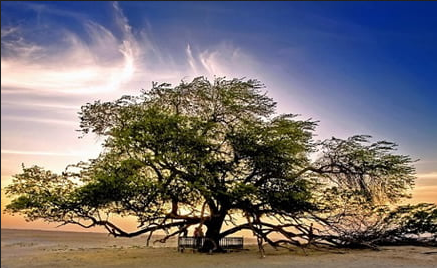Life of Tree in Bahrain: Shajarat-al-Hayat, as it is known in the local language, is a tree that has stood alone amid Bahrain’s Desert. It is called ‘Tree of Life‘ or ‘Life of Tree‘. This tree is believed to be a survivor because of its age and position. It is considered a remarkable natural wonder of the globe experienced by most visitors to Bahrain. Located at Bahrain’s highest point, on the crest of a 25-foot-high sand mound, it stands alone, miles distant from any other natural tree and with no visible supply of water. After reaching 32 feet in height, it has maintained its growth despite the severe temperatures, scarcity of fresh water, and lack of nutritional resources.
Why is it called the tree of life?
In the ancient Celtic Druids’ opinion, the Tree of Life has extraordinary abilities. When they cleared an area for settling, they would leave a solitary tree in the center of the clearing, which became known as the Tree of Life throughout time. It served as a source of food, warmth, and shelter for the local populace and a gathering place for tribal leaders and other significant figures.
Because it also gave nutrition to animals, it was considered responsible for the well-being of all life on earth. They also thought that each tree represented a human being’s lineage back to the beginning of time. According to legend, Celtic tribes would only settle in areas where they could find such a tree.
As a result of the tree sitting in the middle of a scorching and arid desert with no known water source feeding it, it has become known as the Tree of Life, and it epitomizes the magic of life the might of nature.
Where is the tree of life in Bahrain?
The Tree of Life in Bahrain is a Prosopis cineraria, and it is located on a hill in a desolate section of the Desert, 2 kilometers from Jebel Dukhan, Bahrain’s highest point, and 40 kilometers from Manama. The tree’s canopy is densely covered with lush green foliage.
Some believe that the tree is guarded by Enki, an ancient deity of water in Babylonian and Sumerian mythology who safeguards the tree. Those who have this belief continue to think that the place is the historical location of the Garden of Eden. Whichever the answer, the tree has shown no signs of deterioration and continues to serve as an inspiration as it remains tall and strong in the tiny desert nation of Namibia.
How do I get to the tree of life in Bahrain?
To get to the tree, go east on the Zallaq Highway, which becomes the Al-Muaskar Highway after a short distance. You will soon come upon a sign for the Tree of Life, which will direct you to take a right. Even though the sign appears to direct you to turn into a dirt road that leads nowhere, you should refrain from doing so and instead wait until the next crossroads, which is a few meters ahead.
There are no signs along this route, so keep an eye out for a scrap metal yard on your right as you proceed down the road. Take a right just before you reach a hill that tells you that you will be climbing a hard 10 percent grade.
The Tree of Life signs will begin to appear as you continue straight down this road. The signs will direct you along a road that will soon be empty of any signage, but you will finally see the tree in the distance on the right. At Gas Well #371, you make a left onto a dirt path. You can drive up to the edge of the tree, but make sure to stay on the well-worn route since deviating from it would most likely result in your car becoming stuck in the softer sand surrounding the tree.
When should I visit the tree of life in Bahrain?
As you may expect, Bahrain is quite hot. During the summer months, temperatures in the Desert can reach 45 degrees Celsius, while temperatures in Manama can reach 37 degrees Celsius. That effectively eliminates the idea of traveling during June, July, and August – unless you are prepared to deal with those kinds of extreme temperatures.
If heat is a concern, you’ll want to avoid the months of spring and autumn as well, as temperatures seldom drop below 27°C from April to November during these months. So we’ll have to wait till the cooler months of winter to see the Tree of Life in Bahrain in comfort. Heat indexes are at a reasonable 21 degrees Celsius, and rainfall is neither here nor there.
When visiting the Desert, no matter what time of year it is, you will want to escape the midday heat, so plan your visit for the early morning or late afternoon to have a much more comfortable experience. The sunset near the Tree of Life is exceptionally spectacular; come prepared to see some stunning colors dancing across the beaches.
How has the tree of life in Bahrain survived for so long?
With little moisture in these dry regions, there are several ideas on the survival of the Tree of Life, which one may find on the internet. According to reports, its roots may reach depths of up to 50 meters and even reach underground water. On the other hand, some experts suggest that the nearest water source is an underground creek that is roughly 2 kilometers distant. Speculations range from the possibility that it derives its water from winds from the Persian Gulf to the chance that it has discovered how to extract water from grains of sand. There are many non-scientific explanations for the growth and development of this Tree of Life.
What we do know is that the tree survived, presumably because of its solitude at first. Then because of the tales, people began to tell about it later in its history that aided in its survival. As highways made it simpler to get there, that protective effect began to wane over the last few decades as the population increased. (It’s currently just 35 minutes away by automobile from the capital city of Manama, which is an improvement.) Vandals began causing significant damage to the structure by cutting their names onto it. Others set it ablaze, presumably as part of religious ceremonies. A recessed concrete wall and footpath got built around the tree to keep automobiles from coming close to the tree. It seems to have prevented the worst vandalism; people who wish to write their names now tend to use permanent markers instead of paint.
Is the tree of life in Bahrain where the garden of Eden was?
Some believe Bahrain was once the Garden of Eden, the biblical paradise where Adam and Eve ate the forbidden apple, and they are confident their island was once that paradise. It is difficult to imagine this while visiting the Tree of Life because not a single blade of grass grows in the scorching, bone-dry Desert where you are standing. Despite this, it isn’t as far-fetched as it appears. When there was enough water here, the region was a tropical oasis, with rich vegetation and wildlife to be found.
The Tree of Life is a thorny bush called ‘Prosopis cineraria, native to Asia. In addition to gum, aromatics, and candles, the yellow balm makes wine, jam, and meal. The tree thrives even in the driest conditions because of its extensive roots, stretching up to 50 meters. Groundwater is just around 10 meters below the ground’s surface in Bahrain, so they don’t even have to go that far to find it.
Myths about the tree
The mystery of this ancient, lonely tree has intrigued people for decades, possibly centuries; today, it is one of Bahrain’s most popular tourist attractions, decorating souvenir mugs and attracting travelers from all over the world to this arid corner of the nation, including me. According to a local myth, the tree is a remnant of the biblical Garden of Eden. According to another tale, the tree has been there since pre-Islamic times and is guarded by the ancient Sumerian god Enki.
Is it true that the tree of life does not need water?
The mythical prominence of the Tree of Life in Bahrain has been exaggerated to some extent. The ground level where the tree grows is just 9 – 12 meters above sea level, and the groundwater level in this place is higher than the surrounding sea level, making it an ideal position for growing trees. Not far from the tree may be observed several ponds filled with water. The air here is frequently humid, and mesquite has evolved to take advantage of this by absorbing moisture from the surrounding environment. A closer look at the region reveals that there are additional trees in the vicinity.
A lesser tree may be seen around 850 meters to the north of the Tree of Life. The majority of the Prosopis genus species are indigenous to North and South America, known as mesquites. Prosopis cineraria, on the other hand, is indigenous to Asia. These trees are well-known for their ability to grow in arid environments with rainfall as low as 150mm per year and to adapt exceedingly well to desert environments. However, they have extensive root systems that may reach depths of up to 50 meters, making them capable of accessing deep beds of underground water.
What is made from the tree of life?
During an excavation around the tree in October 2010, archaeologists discovered pottery and other artifacts that were 500 years old. In the 1990s, researchers conducted a soil and dendrochronology investigation on the tree. This research revealed that it was an Acacia planted in 1582. The tree’s canopy is densely covered with lush green foliage. In part because of its age and the fact that it is the only significant tree remaining in the region, it has become a popular local tourist attraction, drawing roughly 65,000 visitors each year. The yellow resin produced by the tree gets utilized to produce aromatics, candles, and gum, among other things.
Is the tree of life in Bahrain one of the wonders of the world?
The Tree of Life is one of the most popular tourist sites in the Desert, drawing in thousands of visitors each year. It is one of the most visited tourist destinations in the entire country of Bahrain. Every year, more than 50,000 people come to see the tree. Its enduring appeal can be attributed to its enigmatic survival in the Desert. The surrounding region is also regarded to be a significant archaeological resource. A gravel road leads to the Tree of Life, which may be reached by hiking or biking. It may also be seen from a distance because there isn’t much foliage or construction in the surrounding region. The tree got submitted as one of the world’s wonders, but unfortunately, it did not list. It does not take away from the tree’s magnificence, and thousands still flock around the tree annually.
The takeaway
Since ancient times, the lonely tree has stood as a relic of another world. A marvel that has survived despite all odds. It is a symbol of hope and perseverance. According to a myth, some believe that the Kingdom of Bahrain was the historical site of the Garden of Eden. The tree’s capacity to bloom amid the arid Desert is a reminder of that long-ago utopia on earth. Perhaps the tree’s roots have reached some unearthly supply of water, which has enabled it to thrive in a place where others have failed to thrive.
Among the Arabian desert’s oppressive heat, one mesquite tree stands alone on the side of a hill. Average temperatures exceed 105 degrees Fahrenheit, and temperatures sometimes jump to a scorching 120 degrees. Destructive sandstorms frequently hit the area, yet, the mystery tree continues to generate an abundance of lush green leaves. This magnificent jewel has managed to survive in a world when few others have succeeded. Its ability to withstand such a distant and hostile environment clearly distinguishes it as a Tree of Life.
Recommended Reads
- https://thetravelvirgin.com/most-beautiful-places-to-visit-in-california/
- https://thetravelvirgin.com/top-10-nail-ideas-for-vacation-2021/
- https://thetravelvirgin.com/hiking-at-garden-of-gods/
- https://thetravelvirgin.com/best-places-to-visit-in-the-usa-in-january-top-20/
- https://thetravelvirgin.com/what-hotel-is-in-home-alone-2-movie-inspired-vacation/


